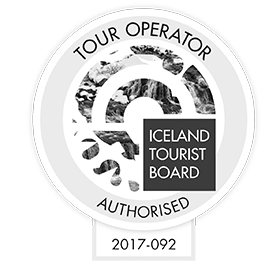- Vehicle Guide
- Passenger cars
- Estate
- Electric
- 4x4 SUVs
- Suzuki Jimny 4x4
- Dacia Duster 4x4
- Suzuki Vitara 4x4
- Suzuki Vitara auto 4x4
- Dacia Bigster 4x4
- Kia Sportage 4x4 Auto
- Kia Sportage PHEV 4x4 auto
- Mitsubishi Outlander PHEV 4x4 auto
- Toyota Rav4 4x4
- Toyota Rav4 4x4 auto
- Kia Sorento 4x4 auto
- Toyota Landcruiser 150 4x4 auto
- Toyota Landcruiser 250 4x4 auto
- Landrover Discovery 5 4x4 auto
- Landrover Defender 4x4 auto
- Prestige
- Minivans
- 4x4 Camper
- Motorhomes
- Driving in Iceland
- Our services
- Locations & Hours
- Travel Inspiration
- South Iceland: A complete guide
- Reynisfjara Beach in Iceland - Your Guide to a Safe Visit
- Best Times to Visit the Golden Circle in Iceland
- North Iceland: A Complete Guide for Drivers
- East Iceland A Complete Guide for Drivers
- West Iceland The Complete Driver’s Guide
- Your Ultimate Guide to Exploring Iceland’s Ring Road
- Driving the Diamond Circle in Iceland: Your Ultimate Guide
- Driving Iceland's Golden Circle: Your Ultimate Guide
- A 10-Day Itinerary in Iceland: Tips + Ideas
- The Perfect Itinerary for 7 Days in Iceland
- The Best Time to See the Northern Lights in Iceland with a Rental Car
- Renting a Camper in Iceland: The Complete Guide
- Getting to Iceland: A Comprehensive Guide on How to Reach the Land of Fire and Ice
- Nature Bath Locations in Iceland: A Complete Guide
- Iceland with Kids: A 5-Day Self-Drive Itinerary
- Winter Driving in Iceland: A Comprehensive Overview for Foreign Tourists
- The Total Solar Eclipse in Iceland – August 12, 2026
- Exploring Iceland's National Parks on a Self-Drive Adventure
- Exploring Iceland's Wonders: A Comprehensive Guide to Activities and Car Rentals
- Springtime in Iceland – Your Comprehensive Travel Guide
- Exploring Iceland's Most Popular Highland Routes
- The Pearls of Westfjords: The Ultimate Guide
- Exploring Iceland's Hidden Gems | Off-the-Beaten-Path Adventures
- Driving in Iceland in June: Tips for a Safe and Scenic Summer Road Trip
- Driving in Iceland in July: Tips, Routes & Rentals
- Driving in Iceland in August: Late-Summer Freedom on the Open Road
- Guide to Skaftafell Iceland Self-Drive A Journey Through Fire and Ice
- Eco-Friendly Road Trips in Iceland, Sustainable Travel Tips
- Photographer’s Paradise Top Scenic Drives in Iceland for Stunning Shots
- Iceland's Folklore and Legends A Road Trip Through Mythical Sites
- Iceland’s Midnight Sun and How to Make the Most of 24-Hour Daylight
- Exploring Iceland’s Viking Heritage: Top Historical Sites
- Chasing Waterfalls: A Road Trip to Iceland’s Most Spectacular Cascades
- Iceland's Volcanic Wonders: A Self-Drive Tour of Active and Dormant Volcanoes
- Tee Off in the Land of Fire and Ice: A Guide to Golfing in Iceland
- Birdwatching in Iceland: Puffins and Beyond
- Iceland’s Diverse Beaches: Beyond the Black Sands
- Icelandic Horses: The Unique Breed of the North
- Beyond the Ring Road: Iceland’s Hidden Scenic Drives
- Iceland’s Ice Caves: A Year-Round Adventure
- Wildlife Watching in Iceland: Where and When to Go
- Iceland’s Hidden Hot Springs: A Self-Drive Guide to Secret Soaks
- Navigating Iceland’s Weather: What to Expect Each Season
- Tröllaskagi Peninsula: Iceland’s Mountainous Marvel — A Scenic Road Trip with Höldur
- Mastering Iceland's Roundabouts: A Driver’s Guide
- Essential Tips for Renting a Car in Iceland
- Navigating Iceland’s One-Lane Bridges: Your Guide to Safe and Scenic Crossings
- Exploring Iceland’s Film Locations by Rental Car
- 5 Must-Visit Destinations Within Two Hours of Keflavík Airport
- Seasonal Car Rental Tips for Iceland’s Summer Festivals
- Understanding Iceland's F-Roads: How to Drive Safely Into the Highlands
- What Makes Iceland Unique: Top 15 Highlights for an Unforgettable Journey
- Driving and Hiking in Harmony: Explore Iceland's Natural Wonders with Höldur Car Rental
- Best Car to Rent in Iceland?
- Avoiding Common Car Rental Mistakes in Iceland
- Making Your Car Rental in Iceland Child-Friendly: Tips for Stress-Free Family Travel
- Exploring Akureyri, Iceland’s Northern Gem, with EasyJet and Europcar
- Renting a Manual or Automatic Car in Iceland
- Discover the Arctic Coast Way in Iceland with Höldur Car Rental
- How to Save on Fuel Costs During Your Iceland Road Trip
- Electric vs. 4x4 Rentals in Iceland: Which is Right for Your Trip?
- Top Scenic Detours Off Iceland's Ring Road
- Top Safety Tips for First-Time Drivers on Iceland’s Roads
- Cultural Pit Stops Along Iceland’s Ring Road
- Your Guide to Exploring Stuðlagil Canyon by Car: Iceland’s Basalt Beauty Awaits
- Day Trip Ideas From Reykjavik by Rental Car
- Visit Glymur Waterfall: The Ultimate Self-Drive Adventure from Reykjavík
- Discover the Volcanic Wonders of Lake Mývatn by Car
- Discovering the Magic of Snæfellsnes Peninsula by Car
- Your Self‑Drive Guide to Gullfoss Waterfall
- A Guide to Seljalandsfoss Waterfall in Iceland: Explore by Car
- Exploring Reykjanes Peninsula A Self Drive Guide
- Exploring Iceland Landmannalaugar by 4x4
- A Beginner's Guide to River Crossings in Iceland
- Best Car Rental Offers for Iceland’s Summer Adventures
- Your Self‑Drive Guide to Þingvellir National Park
- Your Ultimate Guide to Geysir, Iceland: All You Need to Know
- How to Pay for the Vaðlaheiðargöng Tunnel
- Your Guide to Visiting Jökulsárlón Glacier Lagoon
- The Diamond Beach in Iceland: A Sparkling Wonder Worth Visiting
- Parking fines in Iceland: how to pay and what to do if you receive one
- Where to find overnight parking in Reykjavík: a local’s guide for travellers
- How to park for free in Reykjavík: tips to save on your Iceland trip
- How to pay for parking in Reykjavík - A friendly guide for drivers in Iceland
- Game of Thrones Filming Locations in Iceland: A Self-Drive Guide
- How to Choose the Right Car Rental at Keflavík Airport
- Flying Within Iceland: Your Guide to Domestic Routes and Regional Airports
- Top 3 Must-See Attractions on Iceland's Golden Circle
- Hidden Gems Along the Golden Circle Route
- Your Essential Guide to Iceland: Currency, Culture, and Car Rental Tips
- How to Plan the Perfect Golden Circle Self-Drive Tour
- The Comprehensive Guide to Rental Car Sizes at Keflavik Airport
- Húsafell & Hallmundarhraun: Hidden Lava Field Adventures by Car
- Iceland Weather by Month: What to Expect and How to Drive Safely with Holdur Car Rental
- A Guide to Iceland’s Quirky Roadside Attractions
- Exploring Iceland’s Lava Tubes | Self-Drive Cave Adventures with Höldur Car Rental
- Coolcation in Iceland: Self-Drive Your Summer Escape to the North
- Driving Iceland’s Coastal Roads: A Guide to Lesser-Known Peninsulas
- Top Tips for Driving in Iceland Safely Year-Round
- The Best Rest Stops and Viewpoints Along Iceland's Ring Road
- Driving in Iceland in September: Embrace the Autumn Adventure
- Your Guide to Exploring Fjaðrárgljúfur – South Iceland’s Fairytale Canyon
- Explore Reykholt on a Self-Drive Tour in Iceland
- How to Choose the Right Insurance for Your Iceland Car Rental
- Hiking Múlagljúfur Canyon: Iceland’s Hidden Gem You Can’t Miss
- Understanding Iceland's Weather and How It Affects Driving Conditions
- Dyrhólaey: A Complete Self-Drive Guide to Iceland's Breathtaking South Coast
- Where to See Iceland’s Tectonic Plates Up Close
- Scenic Journey on Kjalvegur Road 35 Reykjavik to Akureyri
- Guide to Visiting Svartifoss with a Rental Car
- Kerið Crater Lake in Iceland: A Self-Drive Guide
- Your Complete Guide to Stokksnes, Iceland with a Rental Car
- Hengifoss Waterfall in Iceland: The Ultimate Self-Drive Guide
- Your Complete Guide to Visiting Skógafoss Waterfall with a Rental Car
- Into the Heart of Þórsmörk: Iceland’s Valley of Thunder
- Dynjandi Waterfall in Iceland: The Ultimate Self-Drive Guide
- Visiting Ásbyrgi Canyon in North Iceland by Car: A Complete Self-Drive Guide
- Driving in Iceland in October: Embrace the Autumn Transition
- Hraunfossar: Iceland’s Hidden Gem for Self-Drive Travellers
- Barnafoss Waterfall: Iceland’s Raging Cascade with a Legend
- Driving in Iceland in November: Your Complete Guide to a Spectacular Autumn Adventure
- Fishing in Iceland: All You Need to Know
- Öxarárfoss Waterfall in Iceland: A Self-Drive Guide with Höldur
- Life in Iceland: Essential Guide to Living in the Land of Fire and Ice
- People of Iceland - 12 Fun Facts About Icelanders
- Glaumbær Turf Houses: A Self-Drive Guide to Iceland’s Living History
- Húsavík: Whale Watching Capital of Iceland
- Svínafellsjökull Glacier: A Self-Drive Guide to Iceland’s Ice Giants
- Kirkjubæjarklaustur: A Historic South Coast Gem
- Vík í Mýrdal: South Iceland’s Coastal Treasure
- Namaskard: A Self-Drive Guide to Iceland’s Geothermal Wonderland
- Laufás Heritage Site: Where Iceland’s Past Lives On
- Navigating Iceland's Gravel Roads: Tips for a Safe and Smooth Drive
- Iceland's Best Stargazing Spots for Self-Drive Travellers
- Iceland's Best Picnic Spots: Scenic Stops for Self-Drive Adventures
- Top 5 Family-Friendly Hiking Trails Accessible by Rental Car
- 15 Tips for Travelling to Iceland
- How to Plan a Winter Photography Road Trip in Iceland
- Visiting Gljúfrabúi Waterfall — A Self-Drive Guide
- How to Spot Puffins in Iceland: A Self-Drive Adventure
- Your Essential Guide to Winter Tyres and Safe Driving in Iceland
- Iceland’s Most Active Volcanoes: A Self-Drive Guide
- Iceland’s Most Scenic Bridges and River Crossings: A Self-Drive Guide
- Iceland’s Most Instagrammable Spots for Self-Drive Travellers
- How Cold Is It in Iceland During Winter? A Self-Drive Guide
- Explore Dimmuborgir: A Self-Drive Guide to Iceland's Dark Castles
- The Ultimate Guide to Iceland’s Top 5 Waterfalls by Car
- Iceland’s Best Scenic Routes for Autumn Foliage: A Self-Drive Guide
- The Best Time to Visit Iceland for Self-Drive Travellers
- Self-Drive Adventures to Iceland’s Remote Lighthouses
- Selfoss Waterfall Self-Drive Guide: Explore Iceland Your Way
- All About the Icelandic Sheep
- Vestrahorn: A Self-Drive Guide to Iceland’s Stokksnes Peninsula
- Höfn, Iceland: The Lobster Town Self-Drive Guide
- Exploring Arnarstapi: A Self-Drive Guide
- A Guide to Iceland's Seasonal Foods for Your Road Trip
- Hverfjall Crater, Iceland: A Self-Drive Guide
- Self-Drive Guide to Visiting Askja
- A Self-Drive Guide to Visiting Kerlingarfjöll
- A Self-Drive Guide to Gunnuhver Geothermal Area
- Skriduklaustur, Iceland: A Self-Drive Guide to History & Culture
- Your Ultimate Guide to Visiting the Blue Lagoon in Iceland
- Borgarnes, Iceland: Top Things to Do & Self-Drive Guide
- A Guide to Glaciers in Iceland
- Car Rental Insurance in Iceland: What’s Usually Included, What’s Not & How to Choose
- Best Car Models for Iceland’s Terrain: Recommendations by Route
- Solo Traveller’s Guide to Self-Driving in Iceland
- Exploring Iceland’s Arctic Circle: What to See and Do
- How to Plan a Budget-Friendly Road Trip in Iceland
- The History of Iceland’s National Day: A Self-Drive Celebration
- Where to Spot Whales in Iceland: A Self-Drive Guide
- The Diamond Circle vs. The Golden Circle: Which Route is Right for You?
- Embracing a Greener Journey: Sustainability in Iceland
- Granni: A Self-Drive Guide to Iceland’s Neighboring Waterfall
- Háifoss: A Self-Drive Guide to Iceland’s Tallest Waterfall
- Iceland's Best Camping Spots for Road Trippers
- Gjáin: A Self-Drive Guide to Iceland’s Hidden Oasis
- Iceland's Hidden Waterfalls: Beyond the Tourist Trails
- Hjálparfoss: A Self-Drive Guide to Iceland’s Helping Falls
- Seasonal Self-Drive Itineraries in Iceland: What’s Open When?
- Kirkjufell: A Self-Drive Guide to Iceland’s Most Photographed Mountain
- Fjallabak Nature Reserve: A Self-Drive Guide to Iceland’s Rugged Highlands
- Hrafntinnusker: A Self-Drive and Hiking Guide to Iceland’s Obsidian Wilderness
- When to Visit Iceland: Northern Lights and Ice Caves vs. Hiking and Highland Adventures
- Visiting Laugarvatn Fontana Spa with a Rental Car: A Relaxing Icelandic Getaway
- Hvítserkur Rock: A Self-Drive Guide to Iceland’s Dragon of the North
- Skiing in Iceland: A Self-Drive Guide for Winter Adventurers
- Visiting the Mývatn Nature Baths by Car: A Self-Drive Guide
- Visiting Vök Baths in East Iceland: A Self-Drive Guide
- Visiting Skútustaðir Pseudo-Craters: A Self-Drive Guide
- Visiting Hljóðaklettar: A Self-Drive Guide on the Diamond Circle
- The Ultimate Guide to Exploring Reykjavik with a Rental Car
- Visiting Seljavallalaug: A Hidden Gem in South Iceland
- Guide to Sólheimajökull Glacier by Iceland Car Rental
- Eyjafjallajökull: Iceland’s Glacier Volcano
- Ísafjörður, Iceland: Your Ultimate Self-Drive Guide to the Westfjords
- What Continent is Iceland In? A Traveler's Guide
- Katla Volcano: A Guide to Iceland's Sleeping Giant
- The Magic of Icelandic Water: A Traveler's Guide
- A Guide to Exploring Akureyri by Rental Car
- A Self-Drive Guide to the Krafla Volcanic Region
- 12-Day Iceland Self-Drive: The Complete Itinerary
- Hekla Volcano: A Self-Drive Guide to Iceland's Gateway
- Visiting Deildartunguhver: A Self-Drive Guide to Europe’s Most Powerful Hot Spring
- Exploring Borgarfjörður: A Self-Drive Guide to West Iceland
- Exploring Stórurð: A Self-Drive and Hiking Guide to East Iceland
- Visiting the Forest Lagoon in North Iceland: A Self-Drive Guide
- Driving in Iceland in December: Embrace the Winter Wonderland
- Exploring Grábrók: A Self-Drive Guide to Iceland’s Volcanic Crater
- Exploring Látrabjarg: A Self-Drive Guide to Iceland’s Westernmost Point
- Iceland Car Hire Tips for UK Drivers: What You Need to Know
- 4-Day Iceland Winter Itinerary: The Best of the South
- Mount Mælifell: Iceland’s Emerald Volcano
- How Long to Drive Around Iceland? A Self-Drive Guide
- Driving in Iceland in January
- Exploring Djúpavík: A Self-Drive Guide to Iceland’s Remote Westfjords
- What to Wear in Iceland: Tips for Every Season
- Things to Do in Stykkishólmur: A Self-Drive Adventure Through Iceland’s Magical West
- The Secret Lagoon: Iceland’s Hidden Gem of Relaxation and Discovery
- The Silver Circle of Borgarfjörður: Your Ultimate Self-Drive Guide
- Snæfellsjökull: A Journey to Iceland’s Glacier of Legends
- Car Rental Iceland 4x4: Best 4WD Options for Your Trip
- What to See in Iceland: 20 Places You Don’t Want to Miss
- How to Prepare for an Iceland Road Trip
- Your Guide to Visiting Fagrifoss Waterfall by Car
- Exploring Stakkholtsgjá Canyon: A Self-Drive Adventure in Iceland
- Kolugljúfur Canyon: A Guide to Iceland's Hidden Gem
- Exploring Kvernufoss: A Hidden Gem in South Iceland
- Skógar Museum: A Journey Through Iceland's History
- 2 Days in Iceland: The Perfect Itinerary
- Exploring Berserkjahraun: A Self-Drive Guide to Iceland’s Lava Fields
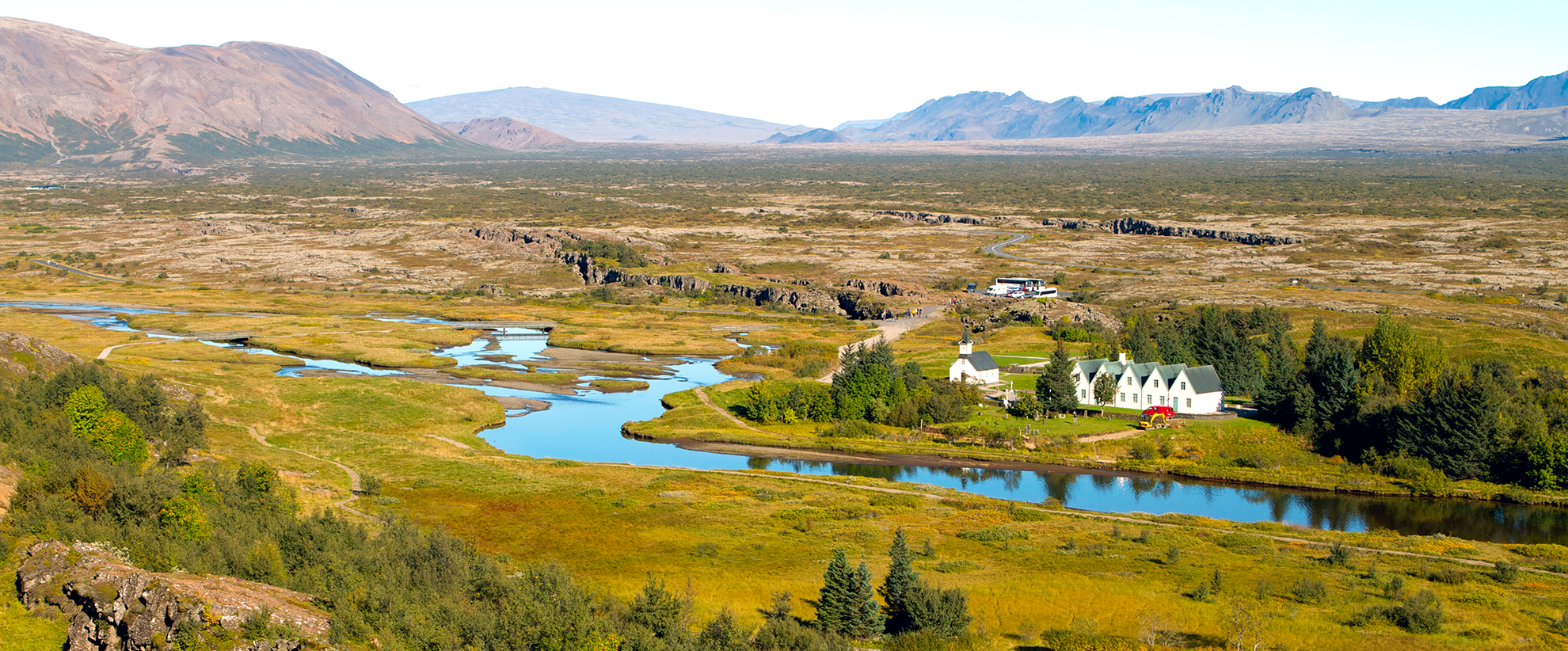
Practical Travel Tips
Where to See Iceland’s Tectonic Plates Up Close
23.08.2025
Iceland is a land of dramatic contrasts, where fire and ice coexist and the earth itself is visibly alive. This is one of the few places on the planet where you can witness the raw power of plate tectonics firsthand, standing directly between two massive continents. The Mid-Atlantic Ridge, which separates the North American and Eurasian tectonic plates, rises above sea level here, creating a landscape filled with deep fissures, vast lava fields, and powerful volcanoes.
For anyone planning an Icelandic adventure, exploring these geological wonders is an unforgettable experience. This guide will show you exactly where to see Iceland's tectonic plates up close. With the freedom of your own vehicle, you can journey to the heart of these incredible sites. Whether you choose a car rental in Reykjavik to start your city escape or decide to rent a car at Keflavik International Airport the moment you land, a self-drive tour is the best way to discover the forces that shape our world at your own pace.
Why Iceland’s Tectonics Are a Must-See
Iceland’s unique position on the Mid-Atlantic Ridge makes it a global hotspot for geological activity. The constant pulling apart of the North American and Eurasian plates, at a rate of about 2.5 centimetres per year, is the engine behind the country's creation and its dynamic landscape. This separation creates rifts and cracks in the earth's crust, allowing molten rock from the mantle to surge upwards, forming new land. This process is responsible for Iceland's numerous volcanoes, geothermal areas, and frequent earthquakes.
Witnessing this isn't just an item for a travel itinerary; it's a chance to connect with the fundamental forces that have shaped Earth for millions of years. Standing in a valley that is widening every day, you can physically see the continental divide. It’s a powerful reminder of how active our planet is. For travellers embarking on self-drive tours in Iceland, these locations offer not just spectacular scenery and incredible photo opportunities, but a deeper understanding of the land they are exploring. It turns a simple road trip into a journey through geological time.
Thingvellir National Park: Where Two Continents Meet
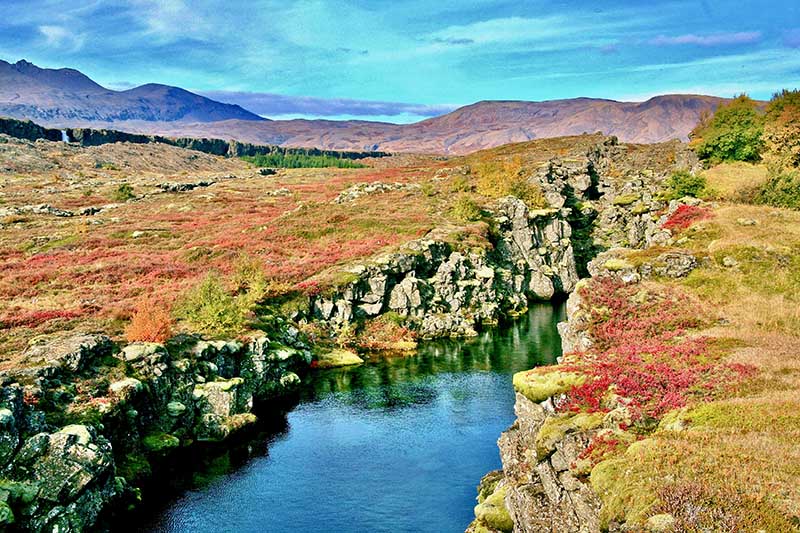
Thingvellir National Park stands as Iceland's crown jewel for witnessing tectonic activity, earning its place as a UNESCO World Heritage Site for both geological and historical significance. Located just 45 kilometres northeast of Reykjavik, this remarkable destination offers the most accessible and dramatic view of the Mid-Atlantic Ridge anywhere in the world. The park sits directly in the rift valley between the North American and Eurasian plates, making it the perfect starting point for your geological adventure.
The drive from Reykjavik to Thingvellir takes approximately 45 minutes along well-maintained roads, making it an ideal destination for those who choose car rental in Reykjavik for their Icelandic exploration. The journey itself offers stunning views of Lake Thingvallavatn, Iceland's largest natural lake, which fills much of the rift valley floor. This scenic route demonstrates why self-drive tours in Iceland provide such flexibility – you can stop at viewpoints, take photographs, and explore at your own pace.
The Almanna Gorge: Standing Between Continents
The park's most striking feature is the Almanna Gorge, a dramatic cliff face that marks the eastern edge of the North American plate. Walking along the designated paths, you'll find yourself literally standing on the North American continent while looking across to Europe. The gorge stretches for several kilometres, with steep rock walls rising up to 40 metres high in places. These towering basalt cliffs tell the story of thousands of years of volcanic activity and plate movement.
What makes Thingvellir particularly special is how clearly you can observe the ongoing separation. The valley floor continues to widen by approximately 2 centimetres each year, and new fissures regularly appear. Recent geological surveys have identified over 100 different fissures within the park boundaries, each representing a moment when the earth literally split apart.
Silfra Fissure: The Ultimate Tectonic Experience
Within Thingvellir National Park lies one of the world's most extraordinary diving and snorkelling sites: the Silfra Fissure. This underwater canyon, filled with glacial meltwater that has been naturally filtered through porous lava rock for decades, offers unparalleled visibility often exceeding 100 metres. The water temperature remains constant at 2-4°C year-round, creating a pristine underwater environment.
Silfra represents the most direct connection between the tectonic plates you can experience. The fissure was formed during a significant earthquake in 1789, and continues to widen gradually. Swimming or diving here means you're literally floating between two continents – your left hand can touch North America while your right touches Europe.
For those planning to experience Silfra during their visit, accessibility by private vehicle is essential. Tour operators require participants to meet at specific locations within the park, and having your own transport ensures you can arrive punctually and explore other areas of Thingvellir at your leisure. Travellers who rent a car at Keflavik International Airport often make Thingvellir their first major destination, combining the geological wonder with practical acclimatisation to Icelandic driving conditions.
Practical Information for Self-Drive Visitors
Thingvellir National Park maintains excellent facilities for independent travellers. The main visitor centre provides comprehensive information about the geological processes at work, while multiple car parks accommodate vehicles of all sizes. The park's road system is well-signposted, with clear directions to major viewpoints and geological features.
The most popular walking route is the path from the main car park down into the rift valley, offering multiple vantage points to observe the tectonic activity. This walk takes approximately 30-45 minutes and is suitable for most fitness levels, though proper footwear is recommended as the terrain can be uneven.
Entry to Thingvellir National Park is free, though parking fees apply during peak season. The park remains accessible year-round, though winter conditions require appropriate vehicle preparation and driving experience. Many visitors combine their Thingvellir visit with the famous Golden Circle route, which includes Geysir geothermal area and Gullfoss waterfall, making it an efficient use of time for those on self-drive tours in Iceland.
The strategic location of Thingvellir makes it an excellent base for exploring Iceland's geological wonders. Its proximity to Reykjavik, combined with the dramatic tectonic features and excellent facilities, demonstrates why this destination consistently ranks among Iceland's most visited natural attractions.
Beyond Thingvellir: Other Spectacular Tectonic Plate Locations
While Thingvellir National Park offers the most accessible tectonic plate viewing experience, Iceland's geological activity extends far beyond this single location. The Mid-Atlantic Ridge continues its dramatic path through the island, creating numerous opportunities for adventurous travellers to witness the forces that shape our planet. These additional destinations offer unique perspectives on tectonic activity and are perfectly suited for those embarking on self-drive tours in Iceland.
The Reykjanes Peninsula: Where Fire Meets Sea
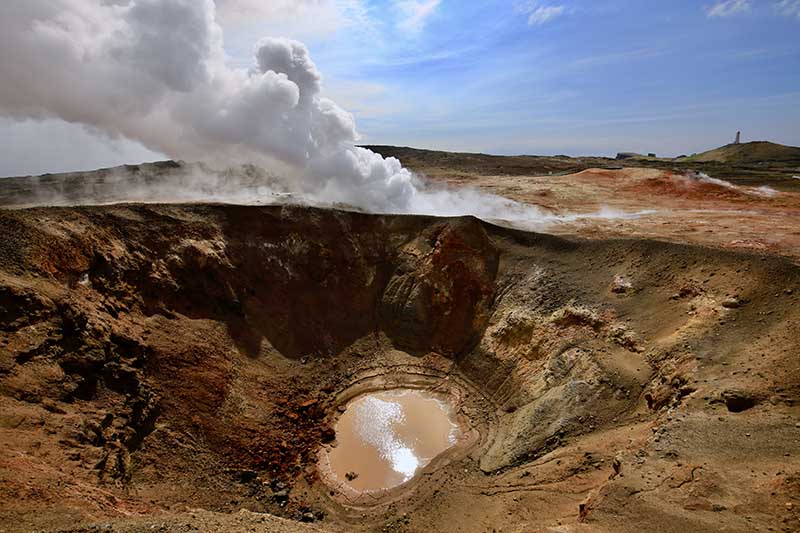
The Reykjanes Peninsula, located just southwest of Reykjavik, provides one of the most dynamic and accessible extensions of the Mid-Atlantic Ridge system. This remarkable region offers a raw, almost otherworldly landscape where volcanic activity, geothermal features, and tectonic movement converge in spectacular fashion. For travellers who rent a car at Keflavik International Airport, the peninsula presents an immediate opportunity to begin their geological exploration before even reaching the capital.
The peninsula's unique position at the intersection of the Mid-Atlantic Ridge and the Reykjanes Ridge creates an environment of intense geological activity. Recent volcanic eruptions, including the 2021-2023 eruption series near Fagradalsfjall, have provided unprecedented opportunities to witness active volcanism up close. These eruptions occur directly as a result of the ongoing tectonic plate separation, making them living demonstrations of the geological processes at work.
The Bridge Between Continents
One of the peninsula's most photographed attractions is the Bridge Between Continents, a symbolic footbridge spanning a fissure in the Mid-Atlantic Ridge. Located near the town of Grindavik, this small but significant structure allows visitors to literally walk from the North American tectonic plate to the Eurasian plate in just a few steps. The surrounding landscape showcases typical rift valley features, including dramatic lava fields, moss-covered rock formations, and evidence of ongoing geological activity.
The bridge area demonstrates how accessible tectonic plate viewing can be when you have the flexibility of car rental in Reykjavik or other locations. The site includes convenient parking facilities and well-maintained walking paths, making it suitable for visitors of all ages and mobility levels. The short walk to the bridge takes approximately 10 minutes from the car park, passing through landscape that clearly shows the effects of plate movement over time.
Gunnuhver Geothermal Area
The Reykjanes Peninsula showcases the connection between tectonic activity and geothermal phenomena at the Gunnuhver geothermal area. This powerful geothermal field, named after a legendary ghost, features some of Iceland's most impressive mud pools and steam vents. The intense geothermal activity here results directly from the tectonic plate movement, as magma chambers close to the surface heat groundwater to create these dramatic displays.
Visiting Gunnuhver provides clear evidence of the underground forces at work along the tectonic divide. The area features several large mud pools that bubble and steam continuously, with temperatures reaching well above 100°C. The wooden boardwalk system allows safe observation of these geological phenomena, while informational signs explain the connection between plate tectonics and geothermal activity.
The Krafla Volcanic System: Northern Tectonic Drama
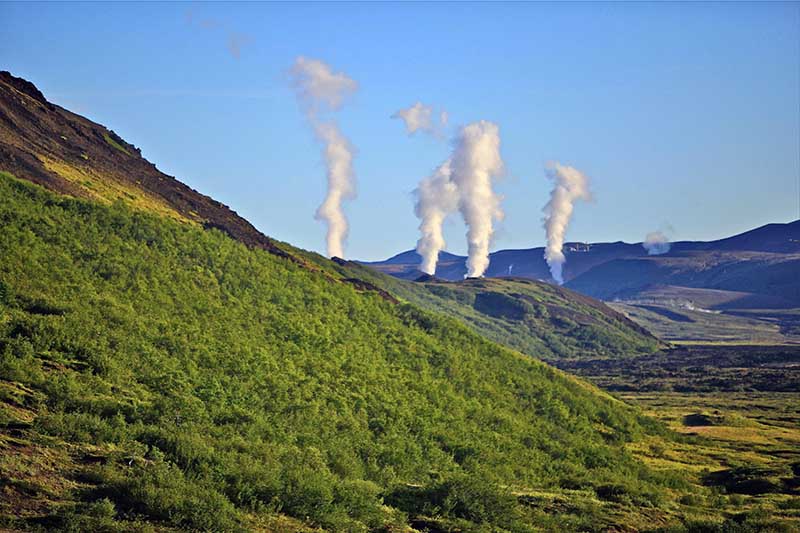
Located in northeastern Iceland near Lake Myvatn, the Krafla volcanic system offers a dramatically different perspective on tectonic plate activity. This region sits directly on the Mid-Atlantic Ridge's northern extension and has experienced significant volcanic and tectonic activity throughout recorded history. The area provides excellent opportunities for visitors on self-drive tours in Iceland to observe the ongoing effects of plate separation in a landscape shaped by repeated volcanic episodes.
The Krafla system includes numerous geological features directly related to tectonic activity, including fissure swarms, volcanic craters, and active geothermal areas. The most recent major activity occurred during the Krafla Fires between 1975 and 1984, a series of rifting episodes that created new fissures and reshaped the local landscape. These events provided scientists with invaluable insights into how tectonic plates separate and create new land.
Leirhnjukur Lava Fields
The Leirhnjukur lava fields represent one of Iceland's most accessible active volcanic areas. Created during the Krafla Fires, these relatively recent lava formations allow visitors to walk across rock that was molten within living memory. The area features clearly defined walking paths that lead across the lava fields, providing close-up views of different types of volcanic rock formations and ongoing geothermal activity.
Steam vents and hot springs throughout the Leirhnjukur area demonstrate the continued geological activity beneath the surface. The landscape changes colour dramatically depending on mineral content and temperature, creating an almost alien environment that clearly shows the power of tectonic forces. The accessibility by private vehicle makes this an excellent destination for independent travellers, with parking available near the main hiking areas.
Viti Crater and Surroundings
The Viti crater, formed during an explosive eruption in 1724, provides another excellent example of how tectonic activity manifests in Iceland's landscape. This explosion crater, now filled with geothermally heated water, sits directly on the plate boundary and offers visitors the opportunity to see both the destructive and creative aspects of geological forces.
The area around Viti includes several other craters and fissures, each telling part of the story of ongoing tectonic activity. Well-marked hiking trails connect the various geological features, allowing visitors to observe different types of volcanic formations and understand how they relate to the broader patterns of plate movement.
The Eldgjá Fissure: A Historical Tectonic Event
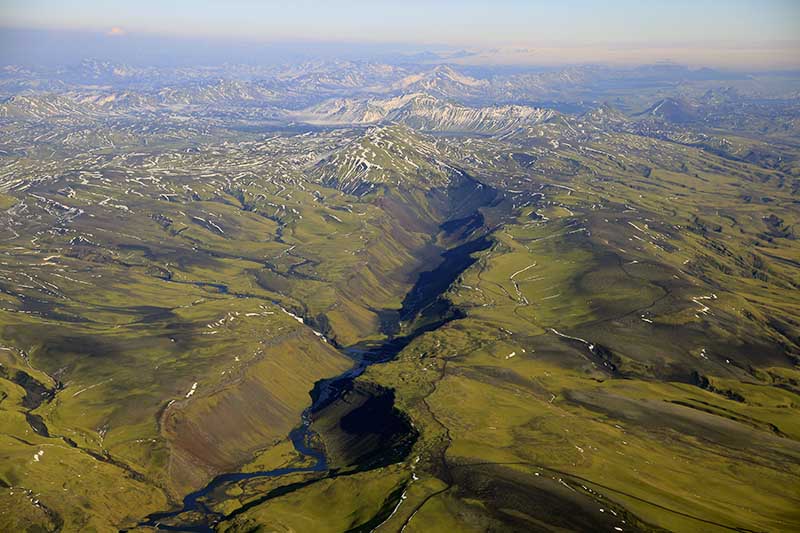
Located in the southern highlands, the Eldgjá fissure represents one of the largest volcanic fissures on Earth and provides dramatic evidence of how tectonic plate activity can reshape entire regions. This 75-kilometre-long fissure system was created during a massive eruption around 934-940 CE, demonstrating the scale at which tectonic forces can operate.
While accessing Eldgjá requires more advanced driving skills and appropriate vehicle preparation, the site offers unparalleled views of large-scale tectonic processes. The fissure cuts through highland terrain, creating a canyon-like formation that visitors can hike into and explore. The scale of the geological formations here provides perspective on how significant tectonic events can be.
For experienced drivers comfortable with highland roads, Eldgjá represents the ultimate tectonic plate viewing experience. The remote location and dramatic landscape offer a sense of connection with geological processes that few other locations can match. Proper preparation and suitable vehicles are essential, making this destination most appropriate for confident self-drive travellers with experience on challenging terrain.
Planning Your Tectonic Plate Road Trip
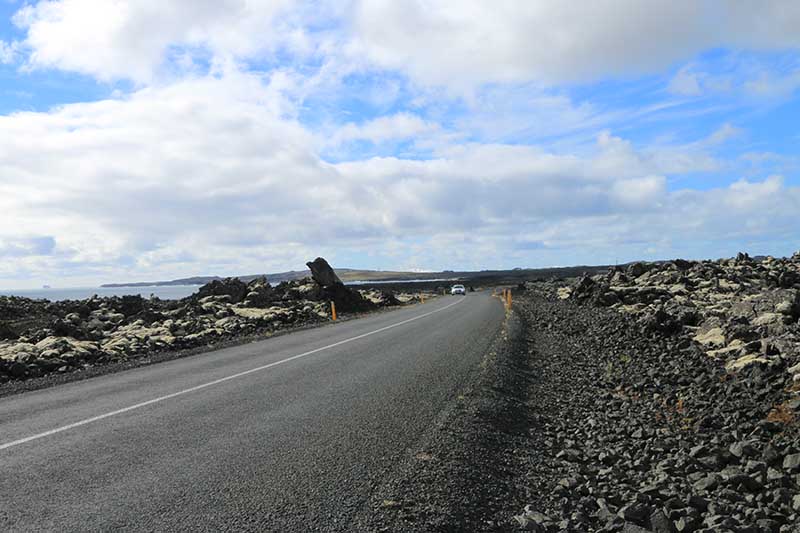
Iceland's network of tectonic plate viewing locations offers numerous possibilities for creating comprehensive geological tours. The strategic use of car rental in Reykjavik allows visitors to plan efficient routes that maximize their exposure to different types of tectonic features while maintaining practical travel logistics.
Each location offers unique perspectives on the same fundamental geological processes, allowing visitors to build a comprehensive understanding of how plate tectonics shapes Iceland's landscape. From the easily accessible Bridge Between Continents to the remote majesty of Eldgjá, these destinations demonstrate the incredible variety of ways that tectonic activity manifests in the natural world.
The flexibility provided by self-drive tours in Iceland proves particularly valuable when exploring these geological sites, as many of the most interesting features require the ability to stop, explore, and spend time observing the landscape at your own pace.
Frequently Asked Questions
What's the best way to reach Iceland's tectonic plate sites with a rental car?
The most convenient approach is to secure car rental in Reykjavik or rent a car at Keflavik International Airport upon arrival. Thingvellir National Park, the most accessible tectonic site, is just 45 minutes from Reykjavik via well-maintained Route 36. The Reykjanes Peninsula locations are even closer to the airport, making them ideal first stops. Most tectonic plate viewing sites are accessible via standard roads, though some highland locations like Eldgjá require 4X4 vehicles and additional driving experience.
Do I need special equipment or permits to visit tectonic plate locations in Iceland?
No special permits are required for visiting the main tectonic plate sites. However, proper preparation is essential for safety and comfort. Sturdy waterproof footwear is crucial as terrain can be uneven and wet. Weather-appropriate clothing is vital year-round, as Icelandic conditions change rapidly. For sites like Silfra Fissure at Thingvellir, specialised diving or snorkelling equipment is provided by tour operators. Self-drive tours in Iceland offer the flexibility to carry extra gear and explore multiple sites efficiently.
Are tectonic plate sites accessible during winter months?
Yes, major tectonic sites remain accessible throughout winter, though conditions require additional preparation. Thingvellir National Park and Reykjanes Peninsula locations are maintained year-round with regular snow clearance. Winter driving in Iceland demands studded winter tyres from November to April), reduced speeds, and increased caution.
How much time should I allocate for visiting tectonic plate locations?
Thingvellir National Park warrants a full half-day to explore the main geological features and visitor centre properly. The Reykjanes Peninsula can be covered in a day trip from Reykjavik, including stops at the Bridge Between Continents and Gunnuhver geothermal area. Northern locations like Krafla typically require 2-3 days when combined with Lake Myvatn attractions. Self-drive tours in Iceland provide the flexibility to adjust timing based on weather conditions and personal interests, allowing for spontaneous stops at geological viewpoints.
What should I expect to see at Iceland's tectonic plate locations?
At these sites, you'll witness the physical separation between the North American and Eurasian tectonic plates through dramatic rift valleys, towering cliff faces, and active fissures. Thingvellir showcases the classic rift valley formation with the impressive Almanna Gorge, while the Reykjanes Peninsula offers active volcanic fields and geothermal features. You'll observe various volcanic rock formations, from recent lava flows to ancient basalt cliffs, plus ongoing geological processes like steam vents and hot springs. Many locations feature clear evidence of recent tectonic activity, including new fissures and evolving landscapes that demonstrate the dynamic nature of Iceland's geological foundation.

Conclusion: Your Journey to Iceland's Geological Heart Awaits
Iceland offers an unparalleled opportunity to witness the planet's most fundamental forces in action. From the accessible rift valleys of Thingvellir National Park to the dramatic volcanic landscapes of the Reykjanes Peninsula and the remote majesty of highland fissures, these tectonic plate locations provide experiences that connect you directly with Earth's geological processes.
The freedom of independent travel proves essential for maximising your tectonic plate exploration. Whether you choose car rental in Reykjavik for a city-based departure or rent a car at Keflavik International Airport to begin your adventure immediately upon arrival, having your own vehicle transforms these geological sites from distant attractions into accessible wonders. Self-drive tours in Iceland allow you to pause at scenic viewpoints, spend extended time observing geological formations, and adapt your itinerary based on weather conditions and personal interests.
Each location discussed offers unique insights into how tectonic forces shape our world. Thingvellir demonstrates the classic rift valley formation where you can literally stand between two continents. The Reykjanes Peninsula showcases active volcanism and geothermal features that result from ongoing plate separation. Northern locations like Krafla provide evidence of recent geological events that have reshaped entire landscapes within living memory.
These sites collectively tell the story of Iceland's creation and continued evolution. Standing beside ancient basalt cliffs, walking across recent lava flows, or observing active steam vents, you gain perspective on geological time scales and the dynamic nature of our planet. This understanding enriches every aspect of your Icelandic journey, from appreciating the island's unique biodiversity to understanding the geothermal energy that powers modern Icelandic society.
The practical benefits of self-drive exploration extend beyond mere convenience. Independent travel allows you to experience these locations at different times of day, when lighting conditions and weather create varying perspectives on the same geological features. Early morning visits to Thingvellir offer serene conditions for photography and contemplation. Evening light on the Reykjanes Peninsula's volcanic fields creates dramatic shadows that emphasise the sculptural quality of the landscape.
Safety and preparation remain paramount for any geological exploration in Iceland. Weather conditions change rapidly, terrain can be challenging, and some locations require specific equipment or driving skills. However, these considerations should inspire thorough planning rather than discourage exploration. Iceland's infrastructure, combined with our comprehensive rental vehicle options and detailed geological site information, makes tectonic plate viewing accessible to travellers with varying experience levels.
The environmental significance of these locations cannot be understated. Witnessing tectonic processes firsthand provides powerful context for understanding climate change, renewable energy, and sustainable living practices that Iceland champions globally. The geothermal features you observe during your visit directly power the clean energy systems that make Iceland a leader in environmental sustainability.
Your journey to Iceland's tectonic plate locations represents more than sightseeing – it's an opportunity to connect with fundamental Earth processes that continue shaping our planet every day. The memories created standing in rift valleys, walking across active lava fields, and observing ongoing geological processes will provide lasting appreciation for our planet's dynamic nature.
Begin planning your geological adventure today. Research rental vehicle options that match your comfort level and intended destinations. Consider seasonal factors that might influence your travel timing. Most importantly, prepare to be amazed by the raw power and beauty of tectonic forces that make Iceland truly unique among world destinations.
The tectonic plates beneath your feet continue their ancient dance of separation and creation. Your visit to witness this geological drama up close will leave you with profound respect for the forces that shape our world and lasting memories of Iceland's extraordinary geological heritage.
Höldur offers over 8,000 vehicles to suit every journey. Need a compact car for city streets? We’ve got it. Heading to the Icelandic highlands? Check out our rugged 4x4 vehicles. With rental locations across Iceland, including at Keflavik Airport, starting your trip has never been easier. Let’s hit the road!




